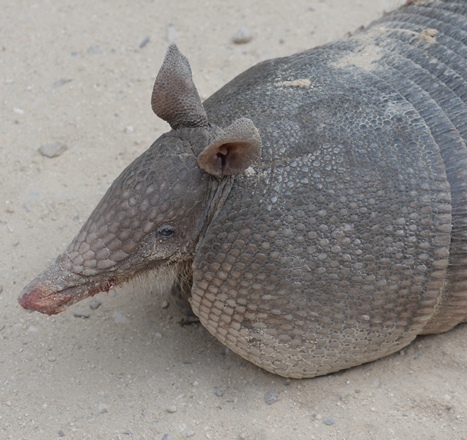
Appearing clumsy and bumbling at first glance, these exotic invaders quickly damage landscapes in search of tasty insects.
It can be pretty discouraging to step out one morning to find a lawn pock-marked like the lunar surface. Stunned surprise then anger is usually the owner’s response.
The offender is not the neighborhood teenager with a reputation for inappropriate practical jokes. The offender is most likely an armadillo, sometimes identified as a Florida-speed-bump or a Possum-on-the-half-shell.
Armadillos eat mostly adult insects and their larvae. They incessantly dig holes in lawns and landscapes in their search for food, many times uprooting plants and turf in their food search. Their holes are approximately one to three inches deep and three to five inches wide.
Using insecticides to decrease the armadillo food supply is not guaranteed, but may help reduce the digging. In cases where there is a large, and always ravenous, armadillo population this reduction of food may increase digging activity as they search more diligently for a smaller food supply.
Another consideration is all chemical treatments have to be re-applied on a permanent basis for impact. Always read and follow label instructions for safe use of insecticides.
To add insult to landscape injury, armadillos burrow under driveways, foundations and patios potentially causing structural damage. Additionally, their burrows in pastures pose a potential leg-injury hazard to livestock.
Burrows openings are approximately seven to eight inches in diameter, about the size of a one-gallon plastic jug, and up to 15 feet in length. The sandy soil is piled up right outside the burrow entrance. Armadillos usually rest in a deep burrow during the day and are most active after dark.
Because armadillos are nocturnal, trapping techniques designed to capture them as they emerge from their burrows should be applied late in the afternoon and checked several hours after darkness. Fencing is another potential option to discourage the presence of armadillos.
Several live-trapping techniques can be used to capture armadillos as they exit of their burrows. One method is to firmly insert a six-inch diameter PVC pipe into the entrance of an active burrow. Adult armadillos will get stuck in the pipe as they try to exit. Another option involves a nylon throw-net staked down to cover the burrow entrance. Armadillos will get tangled in the net as they emerge.
Some can be discouraged from returning to their burrows by filling the hole with a mixture of dirt and mothballs after they have departed for a night of foraging. Laying chicken-wire along a patio, driveway or house foundation will discourage burrowing.
Armadillos can also be trapped using a raccoon-size metal trap, available from local pest control, feed and home improvement stores. These animals are more likely to enter a cage trap with leaf litter or soil placed over the wire bottom.
Suggested baits for the trap are live earthworms or meal worms in surrounding soil placed in hanging bags made of old nylon stockings. Overripe or spoiled fruit which will attract insects may be used as bait. Poison baits are illegal and no chemical repellents or fumigants are registered for use in Florida.
Relocating problem animals is not recommended because it only transfers the problem elsewhere and can spread disease.
To learn more about controlling armadillos contact your local UF/IFAS Extension Office or read Baiting the Nine-banded Armadillo at http://edis.ifas.ufl.edu/uw362
- Get Your Trees Ready For The Winds of October - October 8, 2019
- Feeding Caterpillars Aren’t Always Cute - August 10, 2018
- Wild Azaleas - May 23, 2018
